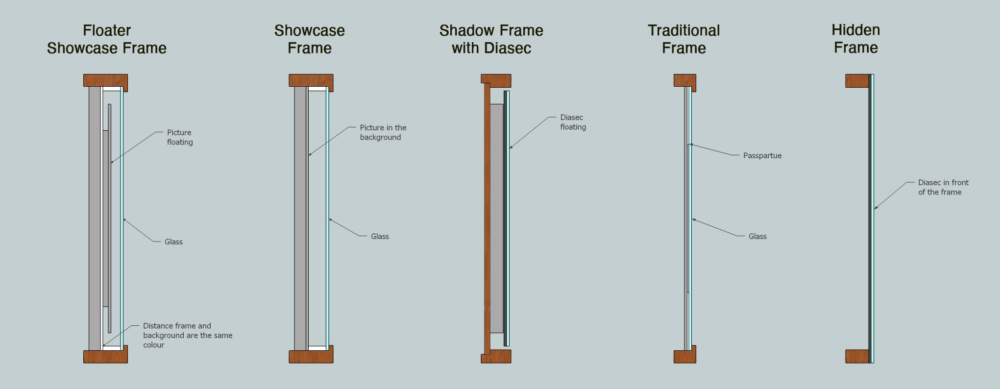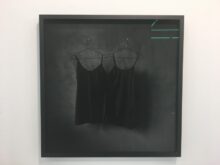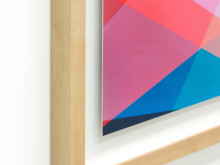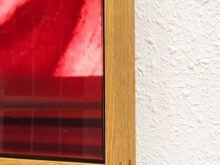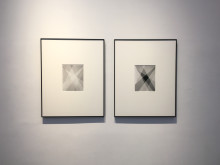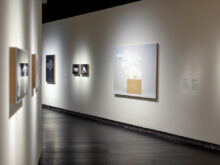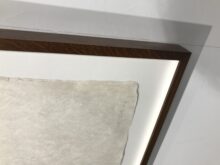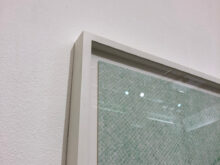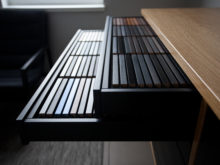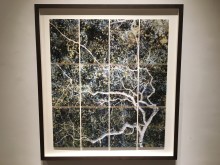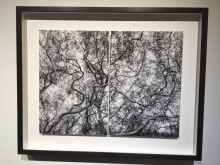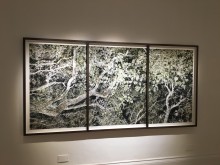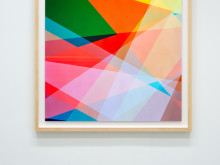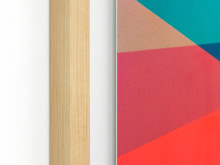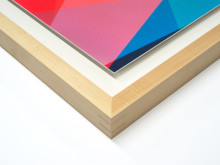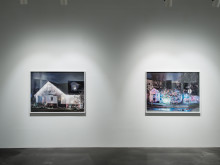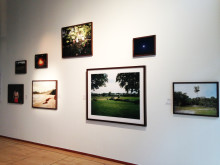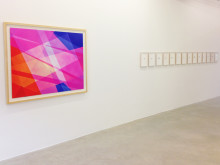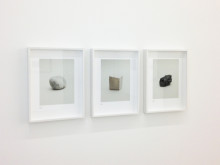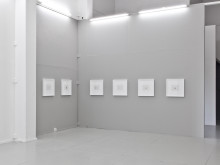Wooden Frames
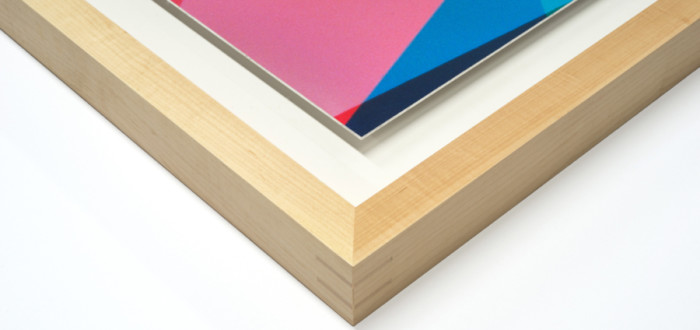
The frame serves to protect the artwork as well as finish it. We offer all commonly used framing options in photographic art.
We produce our frames according to standards that are approved by galleries and collectors around the world. This means that the materials we use and our craftsmanship are and not only superior but our build quality exceeds most regular framing shops.
Materials Used in Framing
Wood
We mainly use birch, beech, maple, oak, ash and walnut as the frame wood.
Maple is a very smooth, stable and strong wood. It’s light in colour and this means that you can achieve beautiful results with lighter staining. When choosing a stain colour, you need to keep in mind that the wood has a yellow hue and this has an effect on the final result. White stain is never pure white, it always dries with some tonality from the wood. Beech and maple are used in painted frames to get the smoothest possible result. Oak is also a very strong and stable wood but it’s darker in colour and has a distinctive texture. Dark brown staining gives the best result on oak. It is also possible to get interesting results with light staining or even paint. Ash has a similar structure to oak but even stronger woodflower. All of the woods give a very elegant look also as natural woods which are finished just with oil or bee’s wax.
Other wood types can also be used when requested, but not all woods are suitable for quality frames. The chosen wood needs to be strong and stable. Some woods are more prone to expanding and warping due to changes in air moisture and temperature. This may result in bent frames and cracked corner joints.
The artist can always choose the exact frame profile measurements, but standard measurements are 7x30mm, 10x35mm, 15x40mm, 20x50mm, 25x50mm, 30x60mm.
*For Shadow frame the thinnest profile possible is 4x40mm.
Closed Corner
Frames with white paint finishing sometimes suffer from microcracks in corners which might become annoyingly visible due to the sharp contrast of black crack on the white frame. In order to avoid that we recommend to use closed corner technique in these situations.
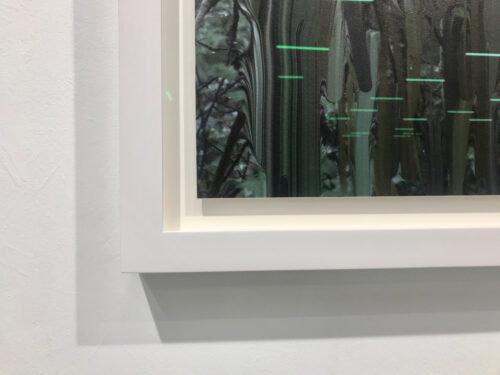
Glass
We offer a range of glass – from basic to the museum quality safety glass. Mostly 2-4mm thick glass is used for framing but 3mm glass covers 80% of our customers needs.
Regular glass is the type commonly used in windows and other household applications. This glass has its distinctive green tint, visible from certain angles. In case of very thin glass (2mm), the green tint is not too visible and the glass can be used in picture framing.
Conversely, white glass is a low iron glass, without any tint. This makes it much better choice for framing purposes.
Museum quality glass is based on white glass but has some additional valuable properties. It offers UV protection and it’s surface is anti-reflective, making it invisible to the eye. This is the most impressive way to present your artwork.
Glass often makes up the lion’s share of the framing cost. We always recommend using museum glass because of it’s remarkable protective and visual properties.
Museum board (matting board)
Matting board (or museum board, or conservation board) is a very important part of floater frames. It creates the background of the frame and serves as a barrier between outside elements and the artwork inside. We use only the best museum quality boards. With easy processing and cutting characteristics, these boards are ideal for conservation quality picture framing, mounting and use as backing supports. The boards are free of optical brightening agents (OBA free) and have passed the Photographic Activity Test. They are age resistant, fade resistant and acid free. In most cases, artists use white or natural white museum board. Natural white museum board has some variations in colour, depending on the manufacturer. The maximum available size museum board is about 180x250cm.
Construction of the frame.
Wooden frame.
All our frames are custom made from start to finish. This means that the artist can choose exactly the size of frame suitable for the artwork. Usually the frame is about 10-25mm wide and 40-50mm deep. The size depends heavily on the size of the artwork. Larger, or heavier, works should have a slightly larger frame to provide additional strength. Frame corners are glued and finger jointed to prevent cracking. The joinery work in the corners is usually visible through the stained surface. This is a good signifier of the quality and strength of the framing.
Please bare in mind that the frame is still made of four different pieces and heavy handling can cause damage even with additional reinforcements. Frames can be finished in a number of different ways. If wood texture and colour are suitable then the wood can just be lacquered with either a matte or glossy finish. Tonality can be added while maintaining the visible wood structure, using staining. After staining, the surface is protected with lacquer. A third popular option is to paint the frame. The choice of colours we have is endless.
Finishing
Artproof wooden frames can be finished in many different ways. Most popular solutions are spray painting and staining.
When spray painting we work according to colour cards (RAL as one sample of many. Both painting and staining are followed by lacquering to adjust the level of gloss and contrast and to protect the surface from stains and grease. If the wish is to have a more rough look then painting and staining can be done with a brush instead of spray gun that delivers the perfect and smooth result.
For natural wood we use oil or beeswax to alter the tonality the least but to still offer protection for the surface.
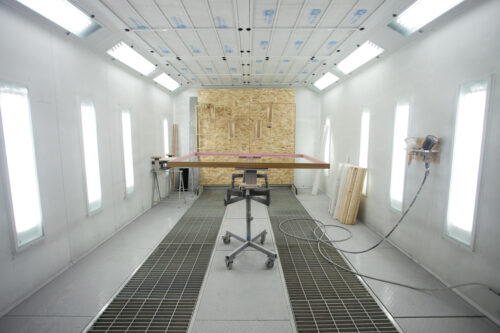
Backframe and hanging system.
A backframe is an important addition to high quality frames. It gives extra strength and forms the base for floater style framing, with the possibility for hanging. Since the frames are usually quite minimal, compared to the total size of the image, then additional strength may be needed to keep the frame from breaking apart and the heavy glass falling out. Additional strength is provided by a backframe. In floater type frames, the backframe also carries all the weight of the mounted image. This way the frame is free from additional stresses.
A backframe is made of a layered wood material which is extremely stable and can handle changes in air humidity and moisture. Although the wood used in visible frames is very stable, it is still regular wood and is subject to swelling and bending. The more stable backframe is attached to the visible frame making it stronger. In addition to strength, the backframe also serves as a hanging system. It has keel-like edges that can be used to mount the work to identical keel-like blocks on the wall. The result is that the work slides in place without leaving any gap between the wall and the frame (eliminating the effect of the work leaning forward, leaving a gap between it and the wall)
Montage
All the pieces are glued and screwed together with precision. The glass and work are cleaned of any debris and fingerprints and is checked multiple times. The frame is closed tightly to keep out dust and preserve the artwork as long as possible. As with all our products we go to extra lengths to make the work look as professional from the reverse as it looks from the front.
XL frames
Artproof labs have the capability of framing XL (oversize) works. The size of floater showcase frames with museum glazing can reach 185x310cm and showcase frames with museum glazing can be produced in size up to 200x300cm. With certain materials the frames can go even bigger.
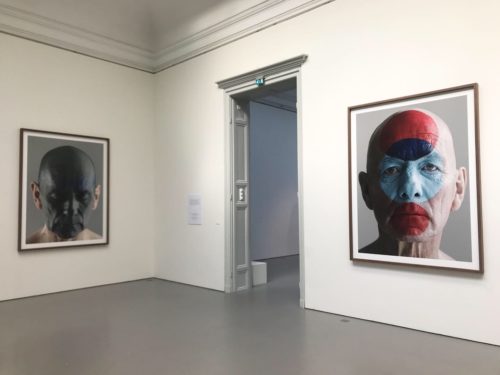
Popular frame types
Floater showcase frame
Floater showcase frame is one of the most popular frame types in the photographic art market. The floater frame effect is combined with the visual effect of the showcase frame as well as with it’s protective properties. The end result is a picture that floats between the bottom of the frame and the glass. Usually a space of 5-10cm is left between the frame and the work, but this distance can be specified.
Showcase frame
Showcase frame – the picture is protected by glass. However, the glass doesn’t sit directly on the picture, but slightly forward within the frame while the picture rests in the back. This adds depth and adds to the mass of the frame.
Shadow frame
Leaves the impression of the art floating in midair, away from the frame. Shadow frame is suitable for paintings on canvas or Diasec®, where the art is already protected by acrylic. This method, when used with aluminium mounted art, has no additional protection from the environment. Therefore we recommend adding protective laminate, either gloss, matt or semi-matt.
Traditional Frame
Classical framing method, where the image is surrounded by passe-partout and glass right on top of it. This is a classical method that especially suits for original artwork.
Traditional Frame can also be used together with Diasec, where the photo edges go under the frame edge.
Hidden Frame
A solution where the wooden frame goes behind Diasec. It creates an interesting solution where the frame elevates the photo but doesn’t cover the image.
